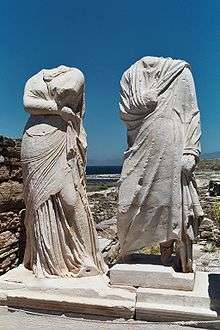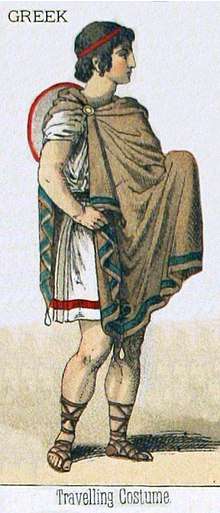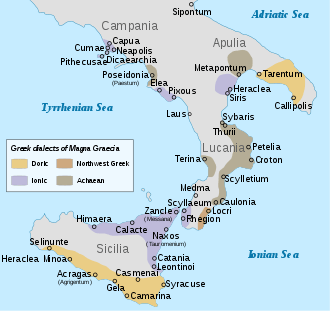Clothing in ancient Greece
Clothing in ancient Greece primarily consisted of the chiton, peplos, himation, and chlamys. Ancient Greek men and women typically wore two pieces of clothing draped about the body: an undergarment (χιτών : chitōn or πέπλος : péplos) and a cloak (ἱμάτιον : himátion or χλαμύς : chlamýs).[1]
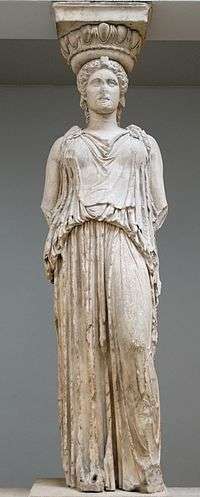
Ancient Greek clothing was mainly based on necessity, function, materials, and protection rather than identity. Thus, clothes were quite simple, draped, loose-fitting and free flowing. Customarily, clothing was homemade and cut to various lengths of rectangular linen or wool fabric with minimal cutting or sewing, and secured with ornamental clasps or pins, and a belt, or girdle (ζώνη : zōnē).
Pieces were generally interchangeable between men and women.[2] However, women usually wore their robes to their ankles while men generally wore theirs to their knees depending on the occasion and circumstance.
While no clothes have survived from this period, descriptions exist in contemporary accounts and artistic depictions. Clothes were mainly homemade or locally made. Additionally, clothing often served many purposes (such as bedding).[3] All ancient Greek clothing was made out of natural fibers. Linen was the most common fabric due to the hot climate which lasted most of the year. On the rare occasion of colder weather, ancient Greeks wore wool.
Common clothing of the time was plain white, or neutral coloured, sometimes incorporating decorative borders.[2] There is evidence of elaborate design and bright colours, but these were less common among lower class citizens.[2] However, noble citizens wore bright colours to express their wealth as dyed clothing was more expensive. The clothing for both men and women generally consisted of two main parts: a tunic and a cloak.
The Greeks had a great appreciation for the human body, and it was shown in their fashion. The fabric was expertly draped around the body, and the cloth could be slightly transparent. Males had no problem with nudity, while women could only be naked in the public bath. They typically wore purple as a sign of wealth and money as it was the most expensive flower (dye) to get hold of.
History and types
Chiton
The chiton was a simple tunic garment of lighter linen and usually pleated that was worn by both sexes and all ages. It consisted of a wide, rectangular tube of material secured along the shoulders and lower arms by a series of fasteners.[4] Chitons typically fell to the ankles of the wearer, but shorter chitons were sometimes worn during vigorous activities by athletes, warriors or slaves.[5]
Often excess fabric would be pulled over a girdle, or belt, which was fastened around the waist (see kolpos).[1] To deal with the bulk sometimes a strap, or anamaschalister was worn around the neck, brought under the armpits, crossed in the back and tied in the front.[1] A himation, or cloak, could be worn over-top of the chiton.
There are two types of chitons – Doric and Ionic, named for their similarities to the Doric and Ionic columns. The Doric chiton is "sleeveless", as sleeve technology had not really been created yet. Much like that on the caryatid above, the Doric chiton has a fold over at the top or apoptygma, is attached with fibulae at the shoulders, and is belted at the waist. Unlike the Doric Chiton, the Ionic chiton doesn't have an apoptygma, and is a long enough rectangle of fabric that when folded in half can complete a wingspan. Before shaped sleeve patterns existed the Greeks attached fibulae (ancient Greek safety pins) all the way up both arms to join the front and back top edges of the fabric. The Ionic chiton was also belted at the waist. The Doric chiton was usually made of linen and the Ionic chiton was usually made of wool.
Peplos
A predecessor to the himation, the peplos was a square piece of cloth that was originally worn over the chiton by women.[4] The top third of the cloth was folded over and pinned at both shoulders, leaving the cloth open down one side.[3] This upper part of the peplos which is folded down to the waist, forms an apotygma. Sometimes the peplos was worn alone as an alternative form of chiton.[2] As with the chiton, often a girdle or belt would be used to fasten the folds at the waist.[1]
Himation
The himation was a simple outer garment worn over the peplos or chiton. It consisted of a heavy rectangular material, passing under the left arm and secured at the right shoulder. The cloak would be twisted around a strap that also passed under the left arm and over the right shoulder. A more voluminous himation was worn in cold weather.[1]
The himation could be pulled up over the head to cover the wearer when they were overcome by emotion or shame.[1]
Chlamys
The chlamys was a seamless rectangle of woolen material worn by men for military or hunting purposes.[1] It was worn as a cloak and fastened at the right shoulder with a brooch or button.
The chlamys was typical Greek military attire from the 5th to the 3rd century BCE.[3]
Undergarments
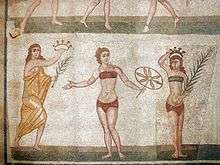
Women often wore a strophion, the bra of the time, under their garments and around the mid-portion of their body. The strophion was a wide band of wool or linen wrapped across the breasts and tied between the shoulder blades.[1] Women could also wear a shawl called an epiblema.
Men and women sometimes wore triangular loincloths, called perizoma, as underwear.[1]
Fasteners and buttons
Since clothing was rarely cut or sewn, fasteners and buttons were often used to keep garments in place. Small buttons, pins and brooches were used.
Large pins, called peronai or fibulae, were worn at the shoulders, facing down, to hold the chiton or peplos in place.[1]
Belts, sashes, or girdles were also worn at the waist sometimes replacing fasteners/buttons.
Footwear
Women and men typically wore slippers, sandals, soft shoes, or boots.[3] At home they usually went barefoot.[3]
Jewellery
Ornamentation in the form of jewellery, elaborate hairstyles and make-up was common for women. Small gold ornaments would be sewn onto their clothing and would glitter as they moved.[1] The Greeks had rings, wreaths, diadems, bracelets, armbands, pins, pendants, necklaces, and earrings. Popular earring designs included: flying gods and goddesses, like Eros, Nike, and Ganymede. Patterns such as the meander symbolizing eternity was also commonly engraved into jewellery. Gold and silver were the most common mediums for jewellery, however jewellery from this time could also have pearls, gems, and semiprecious stones used as decoration. Jewellery was commonly passed down from generation to generation or made as an offering to the gods.
Fabrics
_MET_gr31.11.10.AV1.jpg)
_MET_gr31.11.10.R.jpg)
Ancient Greek clothing was made with silk, linen and wool. However, linen was the most common fiber due to the hot climate. The production of fabric was a long, tedious, and expensive process. It was socially accepted that textile making was primarily women's responsibility, and the production of high quality textiles was regarded as an accomplishment for women of high status.
The most expensive textiles were finely woven linen and very soft wool. Expensive linen was sheer; nudity was not taboo in Ancient Greece. Less expensive and more commonly used textiles were linens woven from flax soaked in olive oil and coarse wool.
Once made, the cloth was rarely cut. The seamless rectangles of fabric were draped on the body in various ways with little sewing involved. The fabric could be crinkled or pleated to give the garment more fullness, as the more fabric one wore, the wealthier they appeared.
Another way of showing wealth was to use colourful dyes. People used to think the Greeks wore only white because the recovered statues from this time showed white drapery. However, they later discovered that the artwork had probably been painted and that the garments the Greeks wore were actually quite colourful.
Colourful dyes were used to show wealth. Recovered sculptures from the period depicted white clothing, but research shows that such works were usually painted. Common dye colours included green, brown, grey, and yellow, while purple was only worn by the wealthy, as purple dye is expensive to produce.
See also
References
- Alden, Maureen (January 2003), "Ancient Greek Dress", Costume, 37.1: 1–16
- Adkins, Lesley, and Roy Adkins. Handbook to Life in Ancient Greece. New York: Facts On File, 1997. Print.
- Ancient Greek Dress Heilbrunn Timeline of Art History, Metropolitan Museum of Art, 2000–2013. Retrieved 7 October 2013.
- Garland, Robert. Daily Life of the Ancient Greeks. Westport, Conn: Greenwood Press, 2009. Print.
- Johnson, Marie, Ethel B. Abrahams, and Maria M. L. Evans. Ancient Greek Dress. Chicago: Argonaut, 1964. Print.
External links
| Wikimedia Commons has media related to Costume in ancient Greece. |
